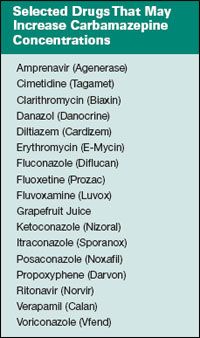Publication
Article
Pharmacy Times
Carbamazepine: Watch for Many Potential Drug Interactions
Awareness prevents complex drug interaction with carbamazepine.
Drs. Horn and Hansten are both professorsof pharmacy at the Universityof Washington School of Pharmacy.For an electronic version of this article,including references if any, visit www.hanstenandhorn.com.
The January 2008 edition of thiscolumn, entitled "Stopping MedicationsCan Cause Adverse Effects"(please visit www.PharmacyTimes.com/StopMedications), discussed therisk associated with withdrawing anenzyme inducer, carbamazepine, whencoadministered with an object drugwhose elimination is susceptible toinduction. During concurrent administrationof an inducer, the object drugdose may be titrated upward to maintaintherapeutic effect. If the inducer isdiscontinued, the induction will slowlydissipate, and the metabolism of theobject drug will return to normal. If thedose of the object drug is not reduced,toxicity may occur.

Carbamazepine is an inducer of severalpotential pathways of drug elimination,including CYPs 1A2, 2C9, and3A4, as well as the active transporterP-glycoprotein. Any drug that undergoesmetabolism via CYP1A2, CYP2C9,or CYP3A4 or is a substrate for the P-glycoproteintransporter, is likely to beaffected by carbamazepine administration,however. The list of drugs thatmay potentially interact with carbamazepineis very large.1
The recognition of interactions resultingfrom the induction of eliminationis usually rather poor. This is due tothe slow onset of the interaction (1-2weeks) and its presentation as a gradualreduction in the therapeutic efficacyof the object drug. It is typical forcarbamazepine to reduce the plasmaconcentration of susceptible objectdrugs by 50%. For many drugs, this degreeof reduction in plasma concentrationwill lead to a reduction inefficacy.
Carbamazepine is primarilymetabolized by CYP3A4 to anactive metabolite that hasabout the same efficacy asthe parent compound. Drugsthat inhibit the metabolism ofcarbamazepine frequentlylead to accumulation andsigns of toxicity.

Since carbamazepine has afairly narrow therapeuticrange, one should be alert forevidence of elevated plasma concentrations,such as dizziness, drowsiness,nausea, vomiting, confusion, and visionor gait disturbances when a drug thatinhibits CYP3A4 is coadministered.Coadministration of inhibitors shouldbe accompanied by careful monitoringof carbamazepine plasma concentrationsand patient response. Carbamazepineside effects may be apparentwithin 2 to 3 days of initiating a drugthat inhibits carbamazepine metabolism.
Because carbamazepine is an inducerof CYP3A4 and a substrate for theenzyme, carbamazepine induces itsown metabolism. Other inducers ofCYP3A4 can affect carbamazepine,however, reducing its plasma concentrations.
The result of an inducer on carbamazepinewould be to reduce its plasmaconcentrations and efficacy. Whilemore of the active metabolite of carbamazepineis likely to be formed, themetabolism of this metabolite alsoappears to be inducible. This complexeffect makes it very difficult to predictwhat net effect will be seen in a patient.Careful monitoring is very important ifan inducer is coadministered with carbamazepine.Discontinuation of aninducer may result in increased carbamazepineconcentrationsand potential toxicity.

Oxcarbazepine (Trileptal)is a related antiepilepticdrug. It too is metabolizedby CYP3A4 and is anenzyme inducer; however,fewer data are availableregarding its effects onother drugs. Pending furtherstudies, it would beprudent to assume thatoxcarbazepine has a similarinteraction profile ascarbamazepine. One comparativestudy on the induction effects of the 2drugs found that carbamazepine was amore potent inducer of CYP3A4 thanoxcarbazepine.2
Carbamazepine represents a drugwith very complex drug interactionpotential. Its narrow therapeutic rangeand potency as an inducer make itimperative to carefully monitor patientsreceiving carbamazepine withother drugs. It is likely to affect theelimination of a wide range of drugsand to be affected by many commontherapeutic agents. Carefully reviewthe drug profile of any patient receivingcarbamazepine for potential drug interactions.
References
- Hansten PD, Horn JR. The Top 100 Drug Interactions: A Guide to Patient Management. Freeland, WA: H&H Publications, LLP; 2008:142-158.
- Andreasen A-, Brosen K, Damkier P. A comparative pharmacokinetic study in healthy volunteers of the effect of carbamazepine and oxcarbazepine on cyp3a4. Epilepsia. 2007;48:490-96.







